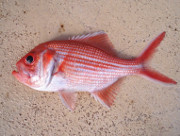Australian Journal of Zoology
Volume 63
Number 4 2015
Higher future air temperatures may provide increased thermal opportunities for reptiles or restrict their activity times. Our research found that an Australian lizard – the jacky dragon – was not able to compensate behaviourally for experimentally restricted basking opportunity, gaining less heat overall and showing reduced reproduction.
Photo by Lisa Schwanz.
This paper describes 14 microsatellite loci for the psylloid, Mycopsylla fici, a pest species feeding on Moreton Bay fig sap (Ficus macrophylla). They will be useful for the study of population genetics and gene flow within and between psylloid populations present in Australia and New Zealand.
Photo by Caroline Fromont.
We identified 26 locations of the endangered freshwater crayfish, Euastacus urospinosus, across 1225 km2 in the Brisbane and Mary River catchments of south-east Queensland, Australia. Using mitochondrial DNA sequence data, we determined that there was significant genetic differentiation among four uplands. Divergence between these populations dated back 2.1 million years.
Photo by Charlotte Hurry.
The western saw-shelled turtle, Myuchelys bellii, is more widely distributed and abundant in New South Wales than previously recognised, comprising four disjunct populations in larger, cooler rivers upstream of barriers to turtle dispersal. It is threatened by competition with an invasive native turtle, Emydura macquarii, and possibly by predation, disease and drought.
Photo by Bruce Chessman.
Artificial shading was highly variable in protecting box traps from solar heating. Tight fitting dark shade cloth actually elevated temperatures above those in unprotected traps. Loose reflective foil covers were the most effective of the methods tested for reducing the rate of heating after sunrise and the maximum temperature reached.
This paper reports on the population size, home range, habitat use, activity patterns, mortality and carrying capacity of two reintroduced numbat populations at Yookamurra and Scotia wildlife sanctuaries. Populations have increased to 169 at Scotia and 44 at Yookamurra from small founder populations. This study shows that numbats can be successfully reintroduced into areas of their former range if protected from introduced predators.
Photo by Aline Poh.
Predation behaviour of Tiliqua adelaidensis was observed by watching video images. Orthopterans were the major prey, and the prey captures peaked in November and December. Our study supports the view that behavioural monitoring could be considered as an integral component of any conservation management of endangered animal species.
Photo by Aaron Fenner.
We describe 16 polymorphic microsatellite markers for Centroberyx gerrardi, a demersal teleost endemic to southern Australia. A number of these markers also amplified in the congeneric C. australis and C. lineatus. The markers will be used to determine whether the current spatial scale of management of C. gerrardi fisheries is appropriate.
Photo courtesy of the Department of Fisheries Western Australia.
The population genetic structure of the skink, Ctenotus fallens, was examined within and among natural vegetation remnants in a highly fragmented urban matrix. Weak genetic differentiation, and a significant association between geographic and genetic distance, suggests historical genetic connectivity that decreases with geographic distance.
Photo by Josef Krawiec.
We report, for the first time, hatchling overwintering inside the natal nest by Chelodina longicollis (Chelidae) in south-eastern Australia. Hatchlings spent, on average, 320 days inside the nest from the date eggs were laid until emergence. These findings expand the phylogenetic range of turtles exhibiting hatchling overwintering behaviour.
Photo by Bruno de Oliveira Ferronato.













